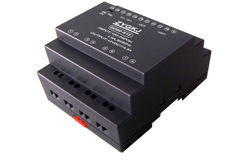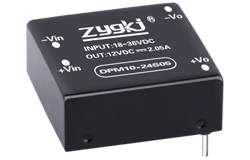nouvelles
How AC-DC Converters Evolved
Auteur: Module d'alimentation ZYG Time: 2023-2-27
An AC-DC converter is a device that converts alternating current (AC) to direct current (DC). This conversion is essential in electronic devices that require a steady supply of DC voltage, such as computers, smartphones, and power tools.
There are two types of AC-DC converters: unregulated and regulated. Unregulated AC-DC converters are simpler and cheaper but provide an unstable output voltage that varies with changes in input voltage and load. Regulated AC-DC converters, on the other hand, provide a stable output voltage that is independent of input voltage and load. Regulated AC-DC converters are widely used in modern electronics, especially in high-performance applications where precise and reliable power is critical.
The basic principle behind an AC-DC converter is rectification, which involves converting AC voltage to DC voltage. The rectification process is achieved through a diode or a group of diodes arranged in a bridge configuration. The AC voltage is fed through the diodes, which only allow current to flow in one direction, effectively converting the AC voltage to a pulsating DC voltage.
The output of the rectifier is still not suitable for electronic devices as it contains ripple, which is a fluctuation in the DC voltage caused by the unfiltered AC component in the rectified output. To remove the ripple and obtain a steady DC voltage, a smoothing capacitor is added to the circuit. The capacitor stores charge when the voltage is high and releases it when the voltage drops, effectively reducing the ripple and producing a stable DC voltage.

While the rectification and smoothing stages produce a DC voltage, it is still not regulated, and variations in input voltage and load can cause the output voltage to fluctuate. To produce a stable DC voltage, an AC-DC converter can be designed with a regulator stage that monitors the output voltage and adjusts it as necessary.
There are various types of regulator circuits used in AC-DC converters, such as linear regulators, switch-mode regulators, and resonant regulators. Linear regulators are simple and reliable but are inefficient and generate heat. Switch-mode regulators are more efficient and generate less heat but are more complex and require additional components. Resonant regulators are relatively new and provide higher efficiency and lower EMI (electromagnetic interference) but are more expensive and require careful tuning.
The choice of regulator circuit depends on the specific application and the desired trade-offs between cost, efficiency, reliability, and complexity. In addition to the regulator circuit, AC-DC converters may also include other components such as protection circuits, feedback circuits, and filtering circuits, depending on the requirements of the application.

AC-DC converters are widely used in various applications, such as power supplies, motor drives, lighting, and renewable energy systems. In power supplies, AC-DC converters are used to convert mains voltage to a lower DC voltage that can be used to power electronic devices. In motor drives, AC-DC converters are used to convert DC voltage to AC voltage to control the speed and direction of motors. In lighting, AC-DC converters are used to convert mains voltage to low-voltage DC voltage that can be used to power LED lights. In renewable energy systems, AC-DC converters are used to convert DC voltage from solar panels or wind turbines to AC voltage that can be used to power homes or businesses.
AC-DC converters are critical components in modern electronics and play an essential role in enabling the efficient and reliable use of electrical energy. With advances in semiconductor technology and the increasing demand for energy-efficient and environmentally friendly products, the development of AC-DC converters is expected to continue, driving innovation and growth in the power electronics industry.
Précédent: Small Size Power Module Suppliers: Choosing the Right One for Your Application
Prochain: Comprendre le rôle des convertisseurs AC-DC dans l'industrie chinoise des énergies renouvelables
les informations pertinentes
-
2023-4-27
AC-DC Converter Module: Turning Alternating Current into Direct Current
AC-DC converter modules are electronic devices that convert alternating current (AC) into direct current (DC). These modules are widely used in various electronic devices, such as computers, televisions, and power supplies. In this article, we will explore the functioning of AC-DC converter modules and their various applications.AC-DC converter modules are composed of several electronic components, such as diodes, capacitors, and transformers. The main function of these components is to rectify, filter, and regulate the voltage of the AC power supply. The rectifier circuit in the module converts the AC voltage into a pulsating DC voltage. The filter circuit removes the unwanted AC components from the pulsating DC voltage, resulting in a smooth DC voltage. The regulator circuit ensures that the...
Voir les détails -
2023-5-16
12V AC-DC Converter: Efficient Power Conversion Solution
Introduction Power conversion is an essential process in many electronic devices. In most cases, voltage levels from an AC source need to be converted to DC voltage levels that can be used by electronic devices. The efficiency of the conversion process is essential as it affects the performance and longevity of the devices. In this article, we will explore the use of a 12V AC-DC converter and how it provides an efficient power conversion solution. What is a 12V AC-DC Converter? A 12V AC-DC converter is an electronic device that converts an AC voltage input into a DC voltage output. It is commonly used in electronic devices that require a stable and regulated DC voltage to operate. The converter is...
Voir les détails -
2023-5-8
AC-DC Converter Module: A Power Conversion Solution
AC-DC converters are power conversion modules that convert the alternating current (AC) voltage from the mains supply into a direct current (DC) voltage that can be used to power electronic devices. These converters are commonly used in various electronic applications as a means of power supply. The AC-DC converter module is an integral part of many electronic devices, including computers, mobile phones, and home appliances. It is used to convert the AC voltage from the mains supply into a DC voltage that can be used to power the electronic components of these devices. The module is designed to be compact, efficient, and reliable, making it ideal for use in a wide range of applications. The AC-DC converter module consists of...
Voir les détails -
2023-5-3
AC-DC Converter Circuit: Design and Implementation
AC-DC Converter Circuit: Design and ImplementationAn AC-DC converter circuit is a device that converts alternating current (AC) to direct current (DC). This type of circuit is commonly used in electronic devices to provide power for their internal components. In this article, we will discuss the design and implementation of an AC-DC converter circuit.DesignThe first step in designing an AC-DC converter circuit is to determine the requirements of the circuit. This includes the input voltage and frequency, output voltage and current, and any other specifications that are required for the specific application.Once the requirements have been determined, the next step is to choose the appropriate circuit topology. There are several different topologies that can be used for an AC-DC converter circuit,...
Voir les détails -
2023-11-16
Introducing the Innovative Concept of Modular PC Power Supply
In the world of technology, advancements are constantly being made to enhance user experience and improve efficiency. One such innovation in the field of computer hardware is the concept of a modular power supply for personal computers. This groundbreaking concept offers users the flexibility to customize their power supply unit according to their specific needs, resulting in a more efficient and organized PC setup. Traditionally, power supply units (PSUs) in personal computers come in a fixed configuration, with a fixed number of cables and connectors. This rigid design often leads to cable clutter and limited flexibility when it comes to adding or removing components. However, with the introduction of modular power supplies, this problem has been effectively addressed. A modular...
Voir les détails -
2023-5-23
How to Convert 110V AC to 12 Volt DC: A Step-by-Step Guide
Converting 110V AC to 12 Volt DC can be a useful skill for anyone interested in electronics or DIY projects. With the right tools and a basic understanding of electrical circuits, you can easily convert AC power to DC power. In this step-by-step guide, we’ll walk you through the process of converting 110V AC to 12 Volt DC. Step 1: Gather Your Materials Before you begin the conversion process, you’ll need to gather the necessary materials. These include: - AC to DC adapter: This device converts AC power to DC power. You can purchase an adapter at your local electronics store or online. Make sure the adapter’s output voltage is 12V DC. - Multimeter: This device measures electric current, voltage,...
Voir les détails


















